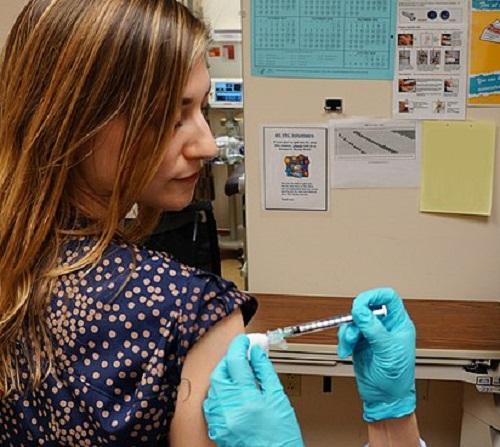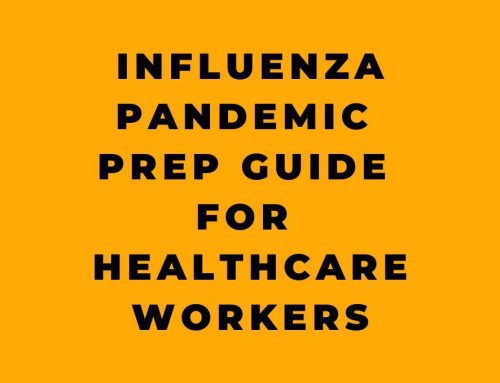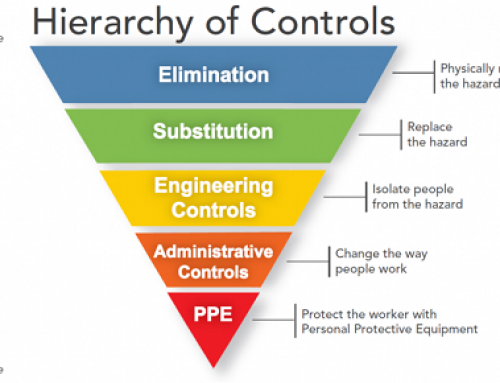Influenza, commonly known as “the flu,” is a highly contagious viral infection that impacts workplaces every year. During flu season, typically between December and February, around 8% of Americans come down with influenza which can spread rapidly in workplace environments. For employers and employees in fields like healthcare, education, hospitality and transportation, understanding flu risks, prevention measures, and response protocols is crucial for maintaining health, safety, and business continuity. This article will provide occupational health and safety best practices for mitigating influenza transmission and managing flu outbreak response in the workplace.
What is Seasonal Influenza?
Influenza, or flu, is a respiratory viral infection caused by influenza viruses which routinely mutate and circulate year-round. While low levels of flu affect the United States annually, prevalence rises significantly in the winter months. According to the Centers for Disease Control and Prevention (CDC), seasonal flu is responsible for around 28 million illnesses, 420,000 hospitalizations, and 35,000 deaths per year in the United States. Flu brings fever, cough, sore throat, congestion, body aches, headaches, fatigue and sometimes vomiting and diarrhea. For vulnerable populations, including adults over 65 and people with chronic medical conditions, flu complications can be life-threatening.
Seasonal flu transmission occurs through contact with virus-laden respiratory droplets and secretions. People with influenza are contagious 24 hours before symptoms emerge until around 7 days after illness starts. Flu virus particles ejected via coughing, sneezing or talking can directly infect others or land on environmental surfaces where they survive up to 48 hours. Touching contaminated objects like doorknobs then transferring the virus by touching the eyes, nose or mouth leads to additional infections.
Given routine person-to-person interactions, shared contact surfaces, and indoor air circulation issues common to many work settings, employers must implement flu prevention and management plans to safeguard occupational health.
Influenza Risk Factors in the Workplace
As a highly contagious and dangerous respiratory illness, flu poses infection risks across all workplaces. However, for particular occupational fields and workplace environments, heightened precautions are warranted.
Healthcare Workers
Personnel directly involved in patient care like doctors, nurses, emergency responders, medical assistants and hospital custodial staff who routinely interact with sick individuals are at greatest risk of flu exposure. This is of heightened concern as influenza infection can reduce healthcare staff availability precisely when community medical needs spike during severe flu seasons.
Congregate Work Settings
Office personnel, retail clerks, hospitality staff and educators often work in enclosed spaces facilitating close interpersonal contact. Such regular proximity with co-workers and customers, coupled with handle high visitor volume, elevate influenza infection risks. Teachers face particular concern as flu quickly spreads in the enclosed environments of crowded schoolrooms full of children, a primary vector of influenza transmission.
Public Transportation Workers
Bus drivers, flight attendants and other transportation staff continuously encounter new individuals in semi-enclosed transit vehicles. Airplanes can also facilitate flu spread through shared recirculated cabin air. These factors increase chances of contact with infected passengers and contaminated surfaces or air droplets.
Residential Care Workers
Staff in nursing homes, rehabilitation centers and related senior/health residential facilities care for high-risk patient populations extremely vulnerable to influenza and its complications. As such workers move regularly between different patient areas, they can easily spread flu infections if proper precautions are not taken.
Seasonal Flu Prevention in the Workplace While no single tactic can completely prevent influenza, implementing layered controls across policies, environment, behaviors and medical countermeasures mitigates infection risks and severity.
Vaccination
Annual influenza vaccination offers the best protection against infection and transmission. As vaccine effectiveness varies based on how closely formulations match actively circulating flu strains, yearly revaccination bolsters immune response to new mutations. The CDC advises most people over 6 months old receive the updated seasonal flu shot by late October for maximum effect. Employers should actively promote on-site vaccination clinics providing free or discounted flu shots encouraging all personnel to participate.
While the vaccine does not guarantee complete immunity, it significantly reduces infection risk and illness severity among those infected. Widespread vaccination also builds herd immunity minimizing transmission chains. Per CDC research, workplaces attaining 80% staff vaccination rates or higher achieved around a 50% flu infection risk reduction compared to just 31% for those with lower than 40% vaccination coverage.
Engineering & Administrative Controls
Various physical and protocol adjustments make workplace environments less conducive to flu transmission while encouraging proper protective behaviors among personnel. Useful tactics include:
- Improving ventilation and air filtration to reduce contaminated airborne droplets and particles
- Configuring staff scheduling and workstations to enable greater interpersonal distancing
- Installing physical barriers like clear acrylic shields to divide workers and visitors
- Providing ample hand sanitizer/washing facilities and face masks/respirators
- Developing flexible leave policies encouraging those feeling ill to promptly isolate
Safe Work Practices
Individual behaviors minimizing influenza spread must become routine among all personnel through workplace culture and education.
- Receive annual flu vaccination
- Stay home when experiencing fever, cough or other flu symptoms
- Maintain six feet of distance from others when possible
- Clean hands thoroughly and frequently, especially after coughing or sneezing
- Cough/sneeze only into sleeves, never hands, turning away from others
- Avoid touching nose, mouth and eyes with unwashed hands
- Disinfect commonly handled objects like phones, tools and surfaces routinely
Quick Detection & Outbreak Response Protocols
Despite extensive safeguards, flu cases will likely occur, especially during severe seasons. Employers must implement infectious disease management plans focused on rapidly detecting initial influenza signs among staff, contacting tracing all possible exposed individuals and containing further spread through isolation/quarantine and enhanced disinfection procedures.
Promptly identifying “index” flu cases gives employers lead time to limit wider transmission chains before outbreaks swell exponentially. Any personnel exhibiting fever, cough and fatigue must immediately don masks, self-isolate and pursue medical testing/care. Areas recently accessed by symptomatic staff also undergo comprehensive disinfection per CDC environmental cleaning guidance.
Isolation, quarantine and staffing contingency policies detailed in preparedness plans aim to balance infection control against maintaining essential operations through complicated influenza periods. Cross-training personnel and planning minimum staffing thresholds allows smoothly bringing in replacements as needed.
Maintaining robust contact tracing and communication channels keeps personnel informed on flu exposures while reminding everyone to strictly adhere to preventative safeguards. Leveraging infection disease notification technologies can streamline providing outbreak updates and managing leave/isolation logistics at scale.
Specific Workplace Recommendations
While the above guidelines cover any workplace, several higher risk occupational fields warrant tailored influenza control advice.
Healthcare Settings
Medical facilities must make flu prevention core to standard infection control programs via:
- Providing free on-site staff vaccination clinics with a goal of 100% personnel participation. Get all affiliated physicians and contractors vaccinated.
- Screening all visitors for flu symptoms before entry, restricting access for those potentially infected. Insist visitors and patients with flu symptoms properly mask.
- Placing hand sanitizer dispensers and bins for used face masks/tissues in all waiting areas, exam rooms, cafeterias and entrances/exits.
- Sharing strict flu isolation and disinfection protocols for managing infected patients throughout clinical/hospital departments.
Long-Term Care Facilities
The high vulnerability yet close interconnectedness of nursing home residents and staff facilitates influenza spread. Assisted living administrators should:
- Vaccinate residents and require vaccination among staff and external caregiver volunteers.
- Prohibit staff working while symptomatic; provide free seasonal flu testing.
- Limit visitors during severe flu seasons or outbreaks. Screen admitted guests for symptoms/fever.
- Review isolation capacity and coordinate with local health departments to transfer infected patients safely off-site.
Schools & Childcare Centers
Children routinely spread influenza bringing home infections acquired in classroom settings. Educators must:
- Encourage vaccination among students, faculty and administrators.
- Emphasize hygiene etiquette through demonstrations and educational activities.
- Enforce strict exclusion policies requiring symptomatic students and teachers to stay home for at least 24 hours fever-free after taking flu medications.
Public Transit
Buses, airplanes, trains and stations should:
- Provide hand sanitizer dispensers/wipes at entrances, exits and strategic locations for passengers and staff.
- Increase air filtration and exchange rates on vehicles and transit terminals where feasible.
- Routinely sanitize all high touch surfaces like kiosks, turnstiles, seats/armrests, doors and ticket machines.
Workplace Flu Safety Starts at the Top
Implementing rigorous flu prevention safeguards and response plans prevents infections, outbreaks and business disruption. While managers directly shape policies and procedures, genuine cultural transformation succeeds through consistent visible leadership commitment. When supervisors role model vigilant hand hygiene, social distancing and staying home when sick, personnel take infectious disease resilience seriously.
This flu season, CEOs must clearly communicate that maintaining workforce health and safety remains an utmost corporate priority. Back bold words with substantive action – make vaccination readily available, relax attendance policies, improve ventilation, distribute masks and accentuate cleaning. Emphasizing compassion and support for those affected or isolated due to flu shows corporate commitment to care. Workplaces taking visible steps safeguarding personnel health will earn loyalty and trust – precious commodities when facing the inevitable disruption of the next flu season and beyond.






